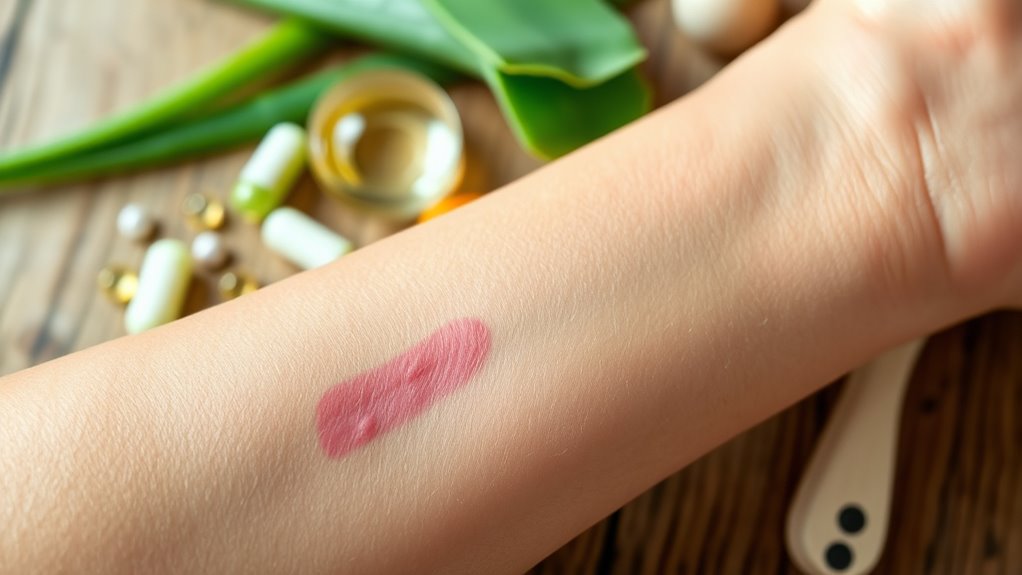To prevent and treat scars effectively, keep your wounds clean and covered, and protect healing skin from sunlight with sunscreen or protective clothing. Use silicone gel sheets or topical treatments early on to help regulate collagen production and reduce raised scars. Gentle massage and moisturizers can support proper remodeling of scar tissue. If scars become problematic, seek medical options like corticosteroid injections or laser therapy. Continue exploring for more tips to optimize your scar healing journey.
Key Takeaways
- Keep wounds clean and protected; apply silicone gel sheets or topical treatments early to modulate collagen production.
- Protect healing skin from UV exposure with broad-spectrum sunscreen to prevent pigmentation and discoloration.
- Gently massage scars to improve blood flow and collagen breakdown, promoting smoother healing.
- Use moisturizers to keep skin supple and support proper scar tissue remodeling.
- Seek medical advice promptly for abnormal or raised scars to explore treatments like corticosteroid injections or laser therapy.

Scars are a natural part of the healing process, but with proper care, you can minimize their appearance. When your skin sustains an injury, your body works hard to repair the damage through a process called scar formation. During this process, your body produces new collagen fibers to replace damaged tissue, forming scar tissue. While this scar tissue helps close wounds and protect underlying layers, it often results in visible scars that can be aesthetically concerning or uncomfortable. Understanding how scar tissue develops allows you to take steps early on to influence how your scars will look later.
Proper scar care minimizes visibility and discomfort by guiding natural healing processes early on.
One of the most effective ways to prevent prominent scars is to manage the wound carefully from the start. Keeping the wound clean reduces the risk of infection, which can worsen scar formation. Applying gentle pressure and using appropriate dressings can also help control the healing process. If you notice the wound is healing unevenly or forming excessive scar tissue, consult a healthcare professional promptly. They may recommend early interventions, such as silicone gel sheets or topical treatments, which have been shown to help modulate collagen production and smooth out the healing process. These treatments work by creating a protective barrier that hydrates the skin and reduces inflammation, which can influence how scar tissue develops.
Another way to prevent or lessen scars involves protecting the healing skin from UV exposure. Sunlight can cause pigmentation changes in scar tissue, making scars more noticeable and sometimes worsening their appearance. Always apply a broad-spectrum sunscreen with at least SPF 30 when you’re outdoors, especially on healing wounds. This simple step can considerably reduce discoloration and help maintain the skin’s natural tone.
As your wound heals, you can also incorporate specific skincare routines to support ideal healing. Gentle massage around the scar site can improve blood flow and break down excess collagen buildup, which sometimes causes raised or thickened scars, such as keloids or hypertrophic scars. Using moisturizing products helps keep the skin supple, promoting better scar tissue remodeling. If a scar becomes raised, itchy, or painful, treatments like corticosteroid injections or laser therapy might be necessary to flatten or reduce the scar’s visibility. Additionally, understanding the importance of color accuracy and proper contrast ratio in imaging can help in assessing how scars might look under different lighting conditions, especially for those concerned about scar discoloration.
Frequently Asked Questions
Can Scars Be Completely Removed With Current Treatments?
Scars can’t be completely removed with current treatments, but you can considerably improve their appearance through scar revision procedures. Silicone gels are effective in reducing scar thickness and redness over time. By consistently using silicone gels and exploring options like laser therapy or corticosteroid injections, you can make scars less noticeable. While complete removal isn’t guaranteed, these treatments can help you achieve a much smoother, more even skin surface.
Are There Natural Remedies That Effectively Prevent Scars?
Did you know that natural remedies can reduce scar formation by up to 50%? You can try herbal applications like aloe vera or calendula to soothe skin and promote healing. Incorporate dietary supplements such as vitamin E and zinc, which support skin regeneration. These natural remedies may help prevent scars, but consistency is key. Always consult a healthcare professional before trying new herbal or supplement treatments for your skin.
How Quickly Should Treatment Be Started After an Injury?
You should start treatment as soon as possible after an injury because timing is vital for minimizing scars. Immediate care helps reduce inflammation, prevent infection, and promote better healing. Clean the wound gently, apply an appropriate ointment, and keep it covered. The sooner you act, the better your chances of preventing prominent scars. Don’t delay, as early intervention considerably improves healing outcomes and scar appearance.
Do Age and Skin Type Affect Scar Formation?
Yes, age and skin type influence scar formation because they affect skin elasticity and wound healing. Younger skin tends to heal faster and has better elasticity, reducing the likelihood of prominent scars. Conversely, older skin may heal more slowly and develop more noticeable scars. Your skin type, such as oily or dry skin, also impacts healing, with some types being more prone to scarring due to differences in collagen production and elasticity.
Are There Any Long-Term Risks Associated With Scar Treatments?
Long-term risks from scar treatments are generally minimal if you follow proper care. However, you should be aware of potential treatment side effects like allergic reactions, skin discoloration, or prolonged healing, especially during scar maturation. Always consult your healthcare provider before starting any treatment, and monitor your skin for unusual changes. Proper guidance helps reduce risks and guarantees your scar heals as smoothly as possible over time.
Conclusion
You might think scars are inevitable, but with proper care, you can substantially minimize their appearance. By following prevention tips and using effective treatments early on, you take control of your skin’s healing process. Remember, even if a scar forms, treatments like silicone gels or dermatologist advice can help fade it over time. Don’t let fear hold you back—acting now can make a real difference in your skin’s future confidence and health.









